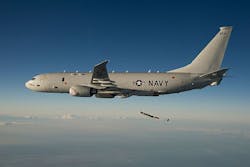Navy eyes high-speed SATCOM capability for P-8A Poseidon surveillance and maritime patrol aircraft
PATUXENT RIVER NAS, Md. – U.S. Navy avionics experts are moving forward with a project to upgrade the Navy fleet of P-8A Poseidon maritime patrol and anti-submarine warfare (ASW) aircraft with high-speed satellite communications (SATCOM) capability.
Officials of the Naval Air Systems Command at Patuxent River Naval Air Station, Md., announced a $16.3 million order last week to the Boeing Co. in Seattle to develop an airworthy design to integrate a Wideband Global SATCOM system radome and supporting infrastructure on the P-8A aircraft.
The Wideband Global satellite communications (SATCOM) system, otherwise known as WGS, is a high-capacity SATCOM link for the U.S. and Australian militaries that will augment and eventually replace Defense Satellite Communications System (DSCS) and Global Broadcast Service (GBS) satellites.
One WGS spacecraft has as much bandwidth as the entire existing DSCS constellation, experts say. WGS will offer 4.875 GHz of instantaneous switchable bandwidth, thus each WGS can supply more than 10 times the capacity of a DSCS III Service Life Enhancement Program (SLEP) satellite.
WGS-1, launched in 2007, has 2.4 gigabit-per-second wideband capacity, which provides greater capability and bandwidth than all the DSCS satellites combined.
Users include the Australian and Canadian militaries, as well as and U.S. Army ground mobile terminals, U.S. Navy ships and submarines, national command authorities for the nuclear forces, and various national security and allied national forces. Previous to the WGS, the U.S. military relied on DSCS and GPS satellites for wideband SATCOM.
The Boeing Defense, Space & Security segment in Seattle will design a WGS SATCOM system radome and supporting infrastructure from a preliminary design review level of maturity to a critical design review level of maturity aboard Navy P-8A aircraft.
The P-8 is a militarized version of the Boeing 737 single-aisle jetliner. It is designed for high- and low-altitude maritime patrol and surveillance.
The P-8A is designed for ASW, anti-surface warfare, and shipping interdiction. It can carry torpedoes, depth charges, Harpoon anti-ship missiles, and other weapons. It also can drop and monitor sonobuoys, and operate together with the Northrop Grumman MQ-4C Triton Broad Area Maritime Surveillance unmanned aerial vehicle (UAV).
The P-8A also has a growing and sophisticated suite for electronic surveillance and signals intelligence (SIGINT) systems which enable the aircraft to widen its role beyond maritime patrol and ASW to strategic reconnaissance duties.
On this order Boeing will do the work in Seattle, and should be finished by October 2018. For more information contact Boeing Defense, Space & Security online at www.boeing.com/company/about-bds, or Naval Air Systems Command at www.navair.navy.mil.
Ready to make a purchase? Search the Military & Aerospace Electronics Buyer's Guide for companies, new products, press releases, and videos

